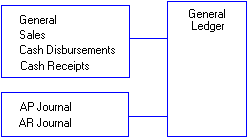Journals and Ledgers
We have described the general principles that govern an accounting system. In this section, we introduce the techniques for recording events that happen to the entity.
In a manual accounting system, the debits and credits for each transaction are first entered in a book called a journal. The journal record for each transaction is called a journal entry, or simply an entry. Later on, the journal entries are copied, or posted, to another book called the ledger.
The journal lists the transactions in the order in which they occur, while the ledger contains a page for each account. In a manual system, the journal tells the bookkeeper which accounts are to be debited and which credited, and in what amounts. The bookkeeper carries out these instructions by posting journal entries to the ledger. Sage 50 does most of this work for you.

You start by deciding which accounts should be debited or credited for a given transaction, and the amounts of the debits and credits.
Each account in the system has an identifying number. In this section, names of accounts are used rather than numbers, to make the procedure easier to follow. In the journal you will enter each account number affected by the transaction, its amount, and whether it is a debit or a credit. You make certain that debits equal credits.